Analysis of Costing Methods, Transfer Pricing, and Outlet Decisions
VerifiedAdded on 2023/01/09
|8
|2164
|47
Report
AI Summary
This report provides a detailed analysis of costing methods, including traditional costing and activity-based costing (ABC), and their impact on product costs for United Motors, Holden Motors, and Leland Vehicle. It compares the results of each method and highlights the implications of using ABC. The report then delves into transfer pricing, determining ideal transfer prices under different capacity scenarios and identifying various approaches to setting transfer prices, such as market-based, cost-based, and negotiation-based methods, along with additional factors to consider for international transactions. Furthermore, the report assesses the financial performance of multiple retail outlets, calculating profit and loss under different allocation methods, and evaluates the financial impact of closing a loss-making outlet, offering recommendations for decision-making based on the findings. The report includes references to support the analysis.
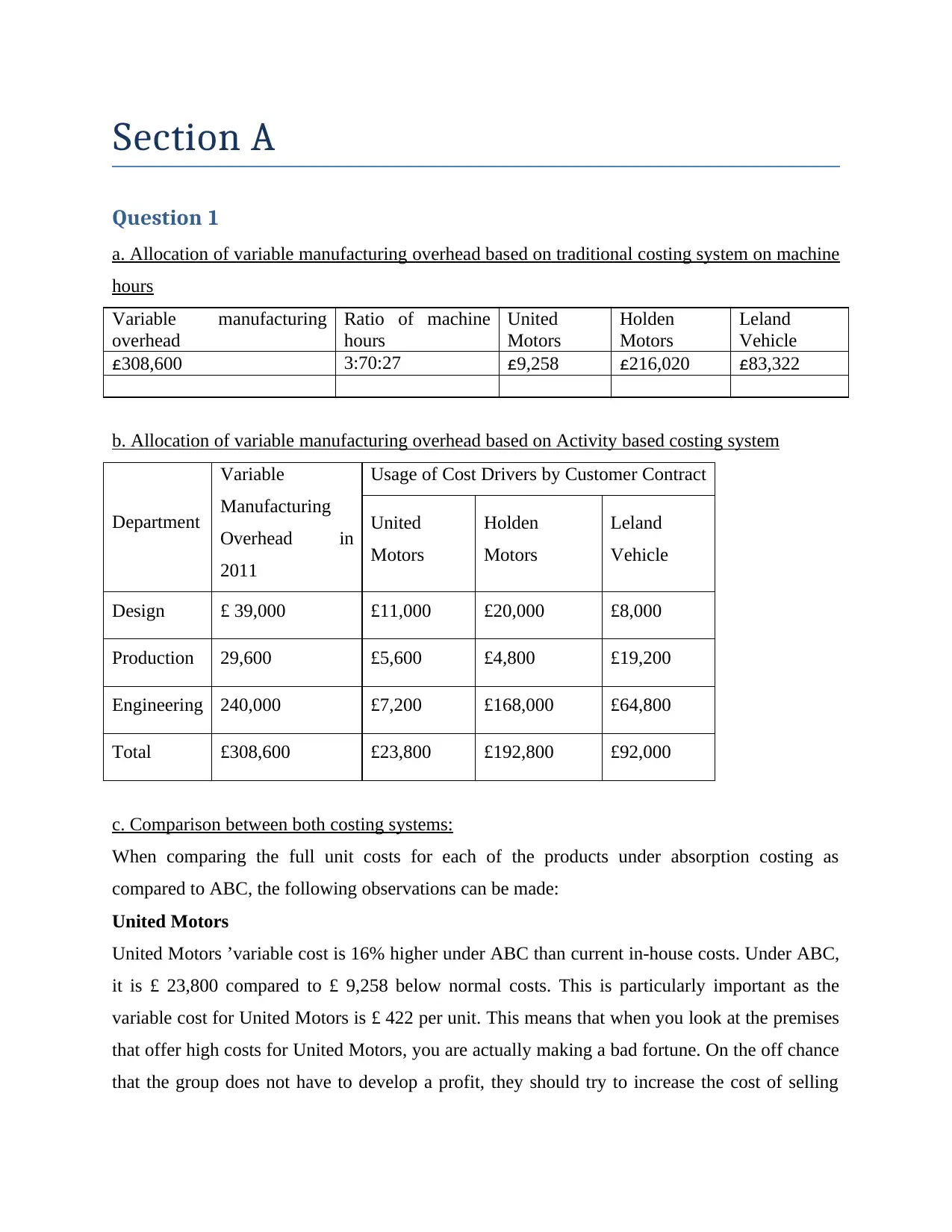
Section A
Question 1
a. Allocation of variable manufacturing overhead based on traditional costing system on machine
hours
Variable manufacturing
overhead
Ratio of machine
hours
United
Motors
Holden
Motors
Leland
Vehicle
£308,600 3:70:27 £9,258 £216,020 £83,322
b. Allocation of variable manufacturing overhead based on Activity based costing system
Department
Variable
Manufacturing
Overhead in
2011
Usage of Cost Drivers by Customer Contract
United
Motors
Holden
Motors
Leland
Vehicle
Design £ 39,000 £11,000 £20,000 £8,000
Production 29,600 £5,600 £4,800 £19,200
Engineering 240,000 £7,200 £168,000 £64,800
Total £308,600 £23,800 £192,800 £92,000
c. Comparison between both costing systems:
When comparing the full unit costs for each of the products under absorption costing as
compared to ABC, the following observations can be made:
United Motors
United Motors ’variable cost is 16% higher under ABC than current in-house costs. Under ABC,
it is £ 23,800 compared to £ 9,258 below normal costs. This is particularly important as the
variable cost for United Motors is £ 422 per unit. This means that when you look at the premises
that offer high costs for United Motors, you are actually making a bad fortune. On the off chance
that the group does not have to develop a profit, they should try to increase the cost of selling
Question 1
a. Allocation of variable manufacturing overhead based on traditional costing system on machine
hours
Variable manufacturing
overhead
Ratio of machine
hours
United
Motors
Holden
Motors
Leland
Vehicle
£308,600 3:70:27 £9,258 £216,020 £83,322
b. Allocation of variable manufacturing overhead based on Activity based costing system
Department
Variable
Manufacturing
Overhead in
2011
Usage of Cost Drivers by Customer Contract
United
Motors
Holden
Motors
Leland
Vehicle
Design £ 39,000 £11,000 £20,000 £8,000
Production 29,600 £5,600 £4,800 £19,200
Engineering 240,000 £7,200 £168,000 £64,800
Total £308,600 £23,800 £192,800 £92,000
c. Comparison between both costing systems:
When comparing the full unit costs for each of the products under absorption costing as
compared to ABC, the following observations can be made:
United Motors
United Motors ’variable cost is 16% higher under ABC than current in-house costs. Under ABC,
it is £ 23,800 compared to £ 9,258 below normal costs. This is particularly important as the
variable cost for United Motors is £ 422 per unit. This means that when you look at the premises
that offer high costs for United Motors, you are actually making a bad fortune. On the off chance
that the group does not have to develop a profit, they should try to increase the cost of selling
Paraphrase This Document
Need a fresh take? Get an instant paraphrase of this document with our AI Paraphraser
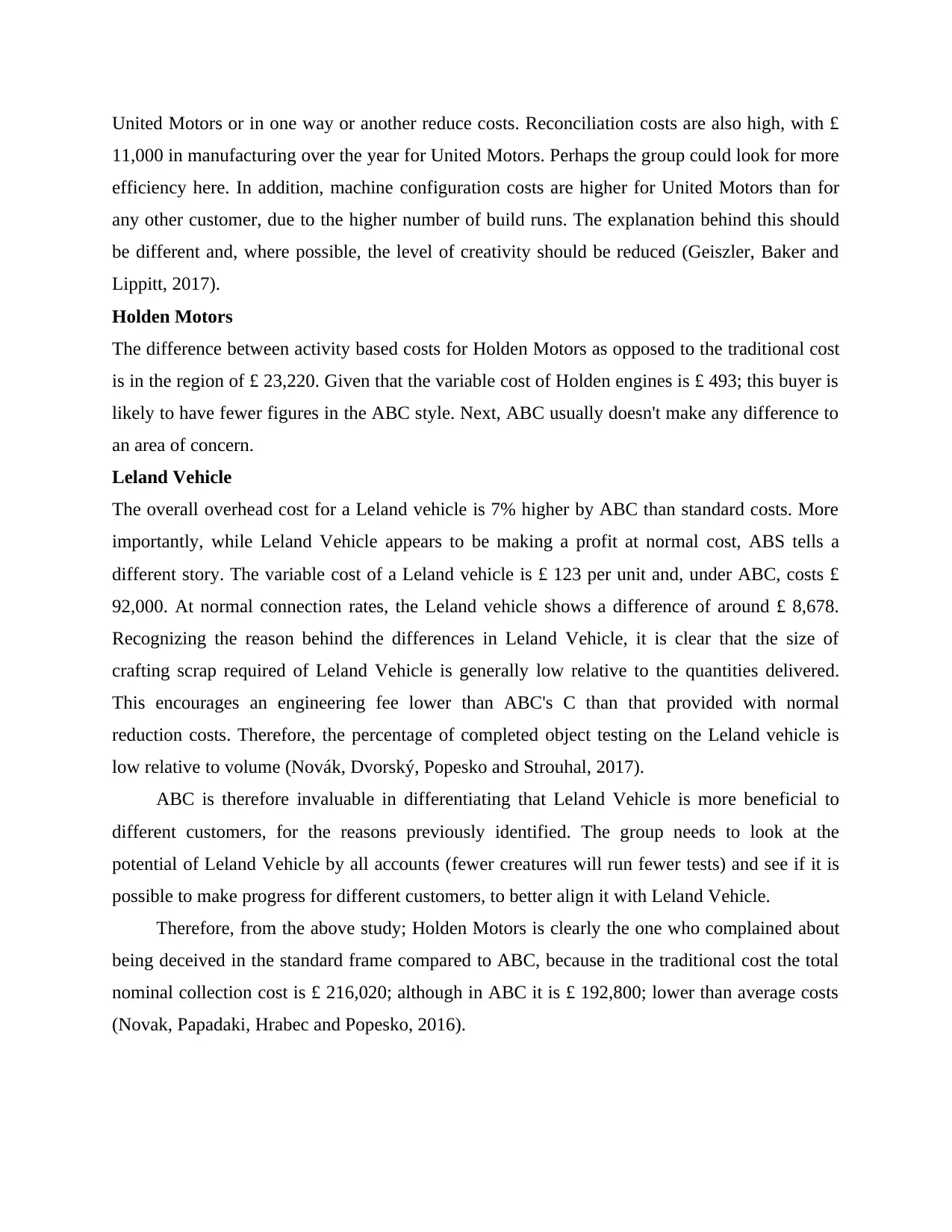
United Motors or in one way or another reduce costs. Reconciliation costs are also high, with £
11,000 in manufacturing over the year for United Motors. Perhaps the group could look for more
efficiency here. In addition, machine configuration costs are higher for United Motors than for
any other customer, due to the higher number of build runs. The explanation behind this should
be different and, where possible, the level of creativity should be reduced (Geiszler, Baker and
Lippitt, 2017).
Holden Motors
The difference between activity based costs for Holden Motors as opposed to the traditional cost
is in the region of £ 23,220. Given that the variable cost of Holden engines is £ 493; this buyer is
likely to have fewer figures in the ABC style. Next, ABC usually doesn't make any difference to
an area of concern.
Leland Vehicle
The overall overhead cost for a Leland vehicle is 7% higher by ABC than standard costs. More
importantly, while Leland Vehicle appears to be making a profit at normal cost, ABS tells a
different story. The variable cost of a Leland vehicle is £ 123 per unit and, under ABC, costs £
92,000. At normal connection rates, the Leland vehicle shows a difference of around £ 8,678.
Recognizing the reason behind the differences in Leland Vehicle, it is clear that the size of
crafting scrap required of Leland Vehicle is generally low relative to the quantities delivered.
This encourages an engineering fee lower than ABC's C than that provided with normal
reduction costs. Therefore, the percentage of completed object testing on the Leland vehicle is
low relative to volume (Novák, Dvorský, Popesko and Strouhal, 2017).
ABC is therefore invaluable in differentiating that Leland Vehicle is more beneficial to
different customers, for the reasons previously identified. The group needs to look at the
potential of Leland Vehicle by all accounts (fewer creatures will run fewer tests) and see if it is
possible to make progress for different customers, to better align it with Leland Vehicle.
Therefore, from the above study; Holden Motors is clearly the one who complained about
being deceived in the standard frame compared to ABC, because in the traditional cost the total
nominal collection cost is £ 216,020; although in ABC it is £ 192,800; lower than average costs
(Novak, Papadaki, Hrabec and Popesko, 2016).
11,000 in manufacturing over the year for United Motors. Perhaps the group could look for more
efficiency here. In addition, machine configuration costs are higher for United Motors than for
any other customer, due to the higher number of build runs. The explanation behind this should
be different and, where possible, the level of creativity should be reduced (Geiszler, Baker and
Lippitt, 2017).
Holden Motors
The difference between activity based costs for Holden Motors as opposed to the traditional cost
is in the region of £ 23,220. Given that the variable cost of Holden engines is £ 493; this buyer is
likely to have fewer figures in the ABC style. Next, ABC usually doesn't make any difference to
an area of concern.
Leland Vehicle
The overall overhead cost for a Leland vehicle is 7% higher by ABC than standard costs. More
importantly, while Leland Vehicle appears to be making a profit at normal cost, ABS tells a
different story. The variable cost of a Leland vehicle is £ 123 per unit and, under ABC, costs £
92,000. At normal connection rates, the Leland vehicle shows a difference of around £ 8,678.
Recognizing the reason behind the differences in Leland Vehicle, it is clear that the size of
crafting scrap required of Leland Vehicle is generally low relative to the quantities delivered.
This encourages an engineering fee lower than ABC's C than that provided with normal
reduction costs. Therefore, the percentage of completed object testing on the Leland vehicle is
low relative to volume (Novák, Dvorský, Popesko and Strouhal, 2017).
ABC is therefore invaluable in differentiating that Leland Vehicle is more beneficial to
different customers, for the reasons previously identified. The group needs to look at the
potential of Leland Vehicle by all accounts (fewer creatures will run fewer tests) and see if it is
possible to make progress for different customers, to better align it with Leland Vehicle.
Therefore, from the above study; Holden Motors is clearly the one who complained about
being deceived in the standard frame compared to ABC, because in the traditional cost the total
nominal collection cost is £ 216,020; although in ABC it is £ 192,800; lower than average costs
(Novak, Papadaki, Hrabec and Popesko, 2016).
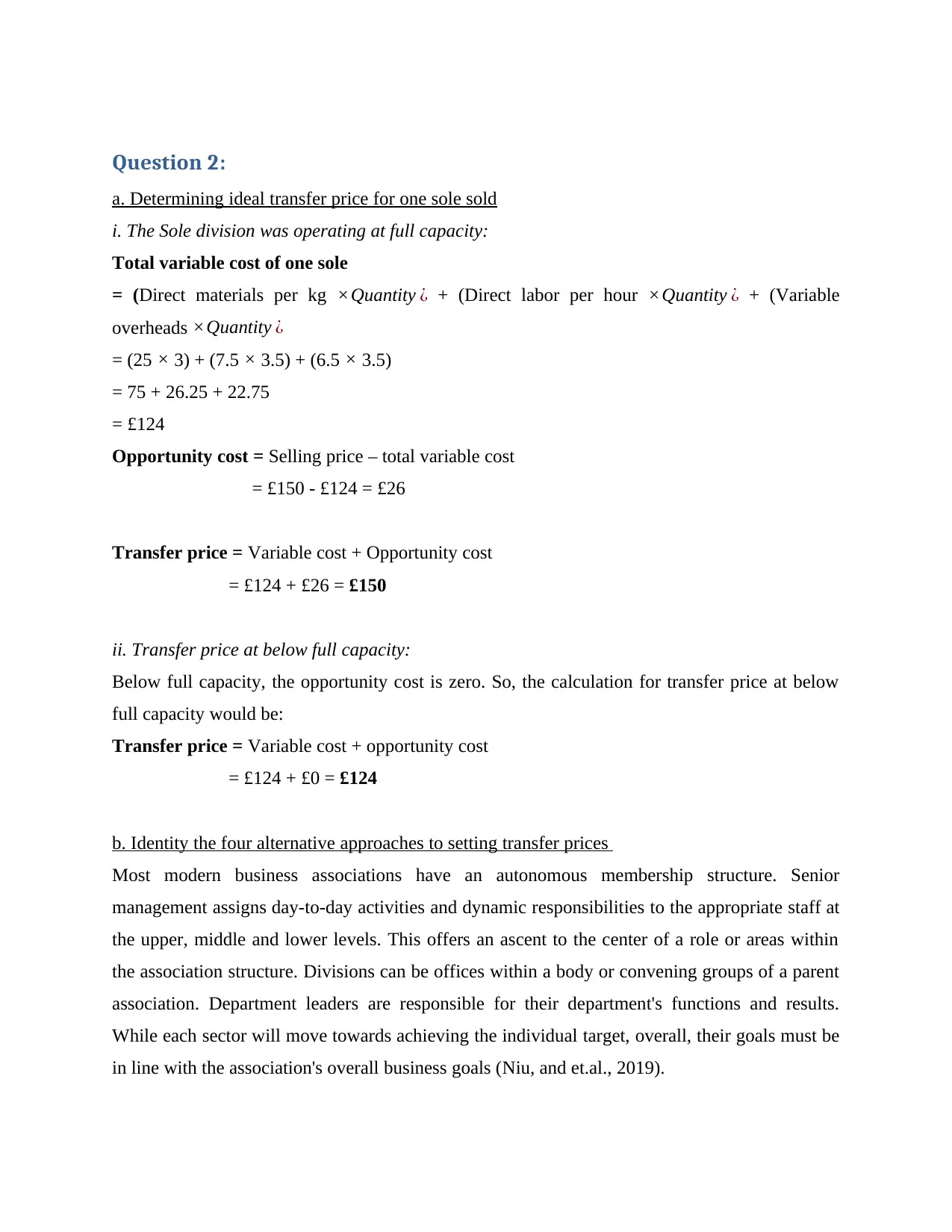
Question 2:
a. Determining ideal transfer price for one sole sold
i. The Sole division was operating at full capacity:
Total variable cost of one sole
= (Direct materials per kg ×Quantity ¿ + (Direct labor per hour ×Quantity ¿ + (Variable
overheads ×Quantity ¿
= (25 × 3) + (7.5 × 3.5) + (6.5 × 3.5)
= 75 + 26.25 + 22.75
= £124
Opportunity cost = Selling price – total variable cost
= £150 - £124 = £26
Transfer price = Variable cost + Opportunity cost
= £124 + £26 = £150
ii. Transfer price at below full capacity:
Below full capacity, the opportunity cost is zero. So, the calculation for transfer price at below
full capacity would be:
Transfer price = Variable cost + opportunity cost
= £124 + £0 = £124
b. Identity the four alternative approaches to setting transfer prices
Most modern business associations have an autonomous membership structure. Senior
management assigns day-to-day activities and dynamic responsibilities to the appropriate staff at
the upper, middle and lower levels. This offers an ascent to the center of a role or areas within
the association structure. Divisions can be offices within a body or convening groups of a parent
association. Department leaders are responsible for their department's functions and results.
While each sector will move towards achieving the individual target, overall, their goals must be
in line with the association's overall business goals (Niu, and et.al., 2019).
a. Determining ideal transfer price for one sole sold
i. The Sole division was operating at full capacity:
Total variable cost of one sole
= (Direct materials per kg ×Quantity ¿ + (Direct labor per hour ×Quantity ¿ + (Variable
overheads ×Quantity ¿
= (25 × 3) + (7.5 × 3.5) + (6.5 × 3.5)
= 75 + 26.25 + 22.75
= £124
Opportunity cost = Selling price – total variable cost
= £150 - £124 = £26
Transfer price = Variable cost + Opportunity cost
= £124 + £26 = £150
ii. Transfer price at below full capacity:
Below full capacity, the opportunity cost is zero. So, the calculation for transfer price at below
full capacity would be:
Transfer price = Variable cost + opportunity cost
= £124 + £0 = £124
b. Identity the four alternative approaches to setting transfer prices
Most modern business associations have an autonomous membership structure. Senior
management assigns day-to-day activities and dynamic responsibilities to the appropriate staff at
the upper, middle and lower levels. This offers an ascent to the center of a role or areas within
the association structure. Divisions can be offices within a body or convening groups of a parent
association. Department leaders are responsible for their department's functions and results.
While each sector will move towards achieving the individual target, overall, their goals must be
in line with the association's overall business goals (Niu, and et.al., 2019).
⊘ This is a preview!⊘
Do you want full access?
Subscribe today to unlock all pages.

Trusted by 1+ million students worldwide
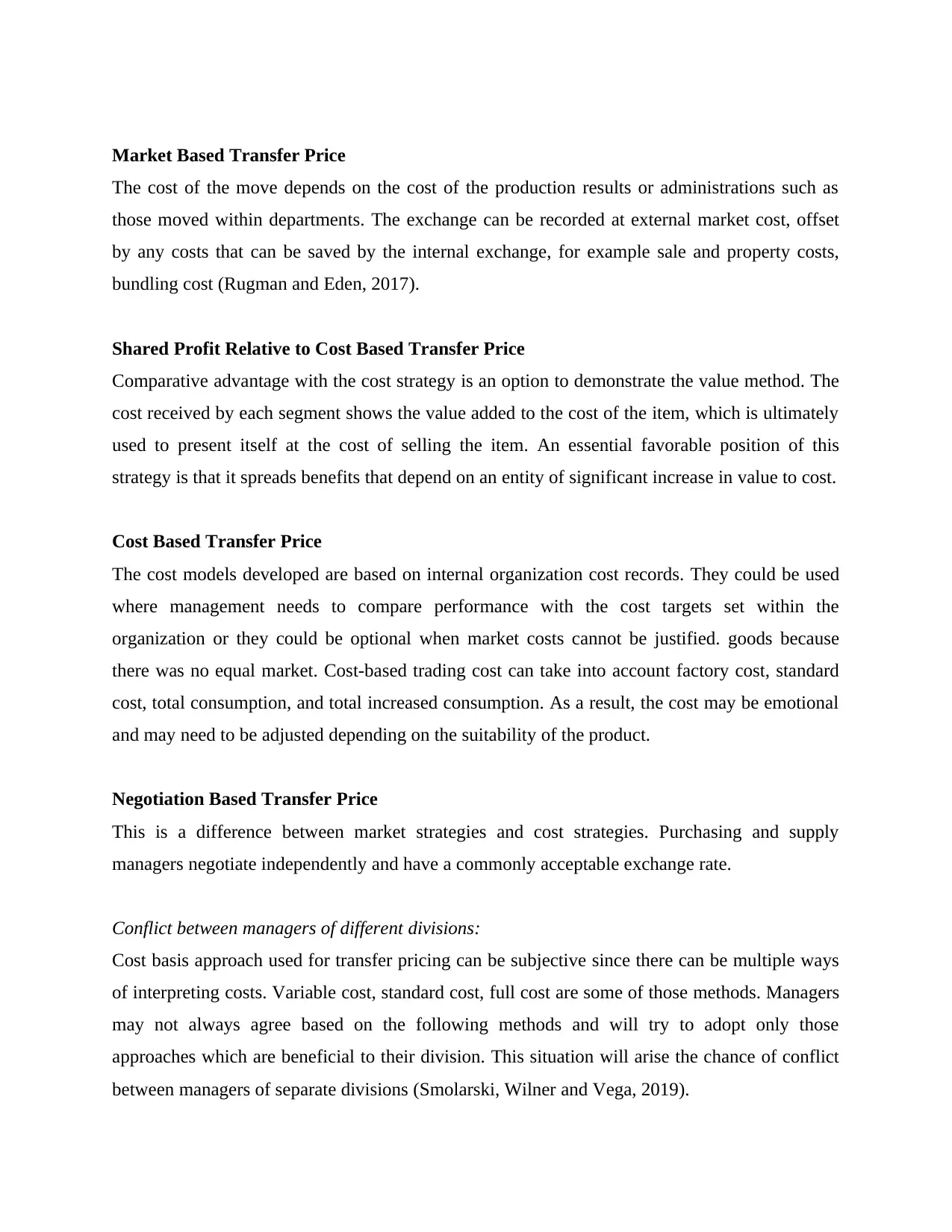
Market Based Transfer Price
The cost of the move depends on the cost of the production results or administrations such as
those moved within departments. The exchange can be recorded at external market cost, offset
by any costs that can be saved by the internal exchange, for example sale and property costs,
bundling cost (Rugman and Eden, 2017).
Shared Profit Relative to Cost Based Transfer Price
Comparative advantage with the cost strategy is an option to demonstrate the value method. The
cost received by each segment shows the value added to the cost of the item, which is ultimately
used to present itself at the cost of selling the item. An essential favorable position of this
strategy is that it spreads benefits that depend on an entity of significant increase in value to cost.
Cost Based Transfer Price
The cost models developed are based on internal organization cost records. They could be used
where management needs to compare performance with the cost targets set within the
organization or they could be optional when market costs cannot be justified. goods because
there was no equal market. Cost-based trading cost can take into account factory cost, standard
cost, total consumption, and total increased consumption. As a result, the cost may be emotional
and may need to be adjusted depending on the suitability of the product.
Negotiation Based Transfer Price
This is a difference between market strategies and cost strategies. Purchasing and supply
managers negotiate independently and have a commonly acceptable exchange rate.
Conflict between managers of different divisions:
Cost basis approach used for transfer pricing can be subjective since there can be multiple ways
of interpreting costs. Variable cost, standard cost, full cost are some of those methods. Managers
may not always agree based on the following methods and will try to adopt only those
approaches which are beneficial to their division. This situation will arise the chance of conflict
between managers of separate divisions (Smolarski, Wilner and Vega, 2019).
The cost of the move depends on the cost of the production results or administrations such as
those moved within departments. The exchange can be recorded at external market cost, offset
by any costs that can be saved by the internal exchange, for example sale and property costs,
bundling cost (Rugman and Eden, 2017).
Shared Profit Relative to Cost Based Transfer Price
Comparative advantage with the cost strategy is an option to demonstrate the value method. The
cost received by each segment shows the value added to the cost of the item, which is ultimately
used to present itself at the cost of selling the item. An essential favorable position of this
strategy is that it spreads benefits that depend on an entity of significant increase in value to cost.
Cost Based Transfer Price
The cost models developed are based on internal organization cost records. They could be used
where management needs to compare performance with the cost targets set within the
organization or they could be optional when market costs cannot be justified. goods because
there was no equal market. Cost-based trading cost can take into account factory cost, standard
cost, total consumption, and total increased consumption. As a result, the cost may be emotional
and may need to be adjusted depending on the suitability of the product.
Negotiation Based Transfer Price
This is a difference between market strategies and cost strategies. Purchasing and supply
managers negotiate independently and have a commonly acceptable exchange rate.
Conflict between managers of different divisions:
Cost basis approach used for transfer pricing can be subjective since there can be multiple ways
of interpreting costs. Variable cost, standard cost, full cost are some of those methods. Managers
may not always agree based on the following methods and will try to adopt only those
approaches which are beneficial to their division. This situation will arise the chance of conflict
between managers of separate divisions (Smolarski, Wilner and Vega, 2019).
Paraphrase This Document
Need a fresh take? Get an instant paraphrase of this document with our AI Paraphraser
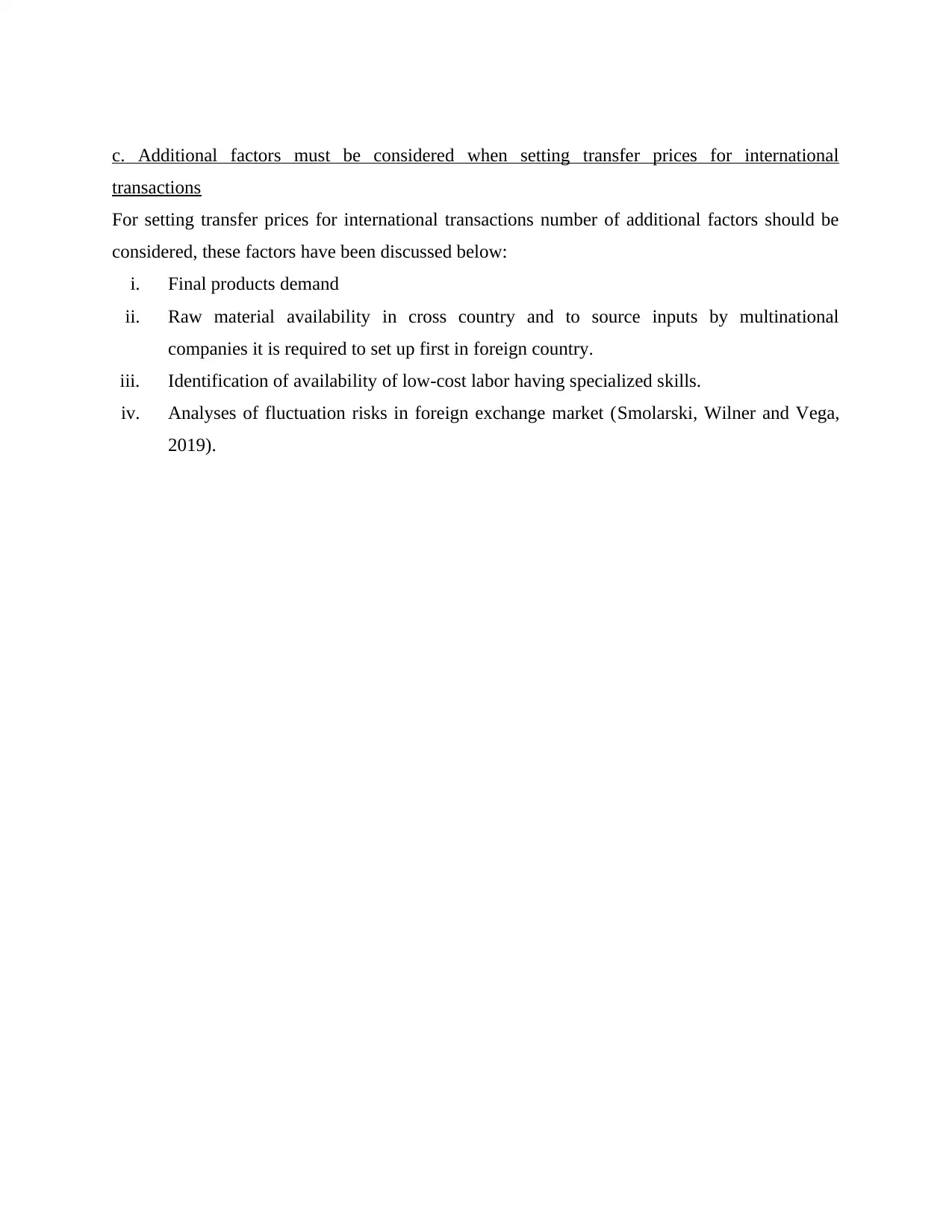
c. Additional factors must be considered when setting transfer prices for international
transactions
For setting transfer prices for international transactions number of additional factors should be
considered, these factors have been discussed below:
i. Final products demand
ii. Raw material availability in cross country and to source inputs by multinational
companies it is required to set up first in foreign country.
iii. Identification of availability of low-cost labor having specialized skills.
iv. Analyses of fluctuation risks in foreign exchange market (Smolarski, Wilner and Vega,
2019).
transactions
For setting transfer prices for international transactions number of additional factors should be
considered, these factors have been discussed below:
i. Final products demand
ii. Raw material availability in cross country and to source inputs by multinational
companies it is required to set up first in foreign country.
iii. Identification of availability of low-cost labor having specialized skills.
iv. Analyses of fluctuation risks in foreign exchange market (Smolarski, Wilner and Vega,
2019).
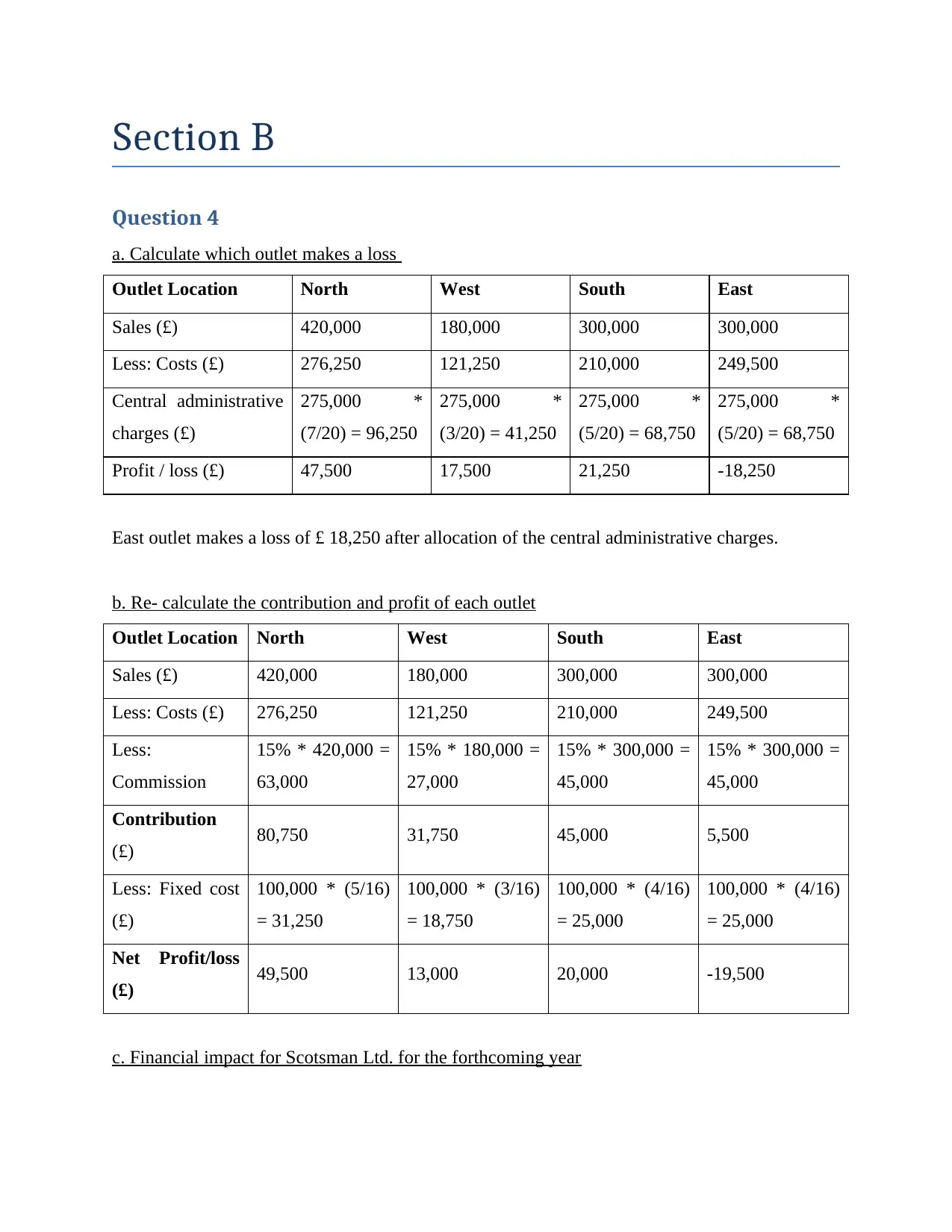
Section B
Question 4
a. Calculate which outlet makes a loss
Outlet Location North West South East
Sales (£) 420,000 180,000 300,000 300,000
Less: Costs (£) 276,250 121,250 210,000 249,500
Central administrative
charges (£)
275,000 *
(7/20) = 96,250
275,000 *
(3/20) = 41,250
275,000 *
(5/20) = 68,750
275,000 *
(5/20) = 68,750
Profit / loss (£) 47,500 17,500 21,250 -18,250
East outlet makes a loss of £ 18,250 after allocation of the central administrative charges.
b. Re- calculate the contribution and profit of each outlet
Outlet Location North West South East
Sales (£) 420,000 180,000 300,000 300,000
Less: Costs (£) 276,250 121,250 210,000 249,500
Less:
Commission
15% * 420,000 =
63,000
15% * 180,000 =
27,000
15% * 300,000 =
45,000
15% * 300,000 =
45,000
Contribution
(£) 80,750 31,750 45,000 5,500
Less: Fixed cost
(£)
100,000 * (5/16)
= 31,250
100,000 * (3/16)
= 18,750
100,000 * (4/16)
= 25,000
100,000 * (4/16)
= 25,000
Net Profit/loss
(£) 49,500 13,000 20,000 -19,500
c. Financial impact for Scotsman Ltd. for the forthcoming year
Question 4
a. Calculate which outlet makes a loss
Outlet Location North West South East
Sales (£) 420,000 180,000 300,000 300,000
Less: Costs (£) 276,250 121,250 210,000 249,500
Central administrative
charges (£)
275,000 *
(7/20) = 96,250
275,000 *
(3/20) = 41,250
275,000 *
(5/20) = 68,750
275,000 *
(5/20) = 68,750
Profit / loss (£) 47,500 17,500 21,250 -18,250
East outlet makes a loss of £ 18,250 after allocation of the central administrative charges.
b. Re- calculate the contribution and profit of each outlet
Outlet Location North West South East
Sales (£) 420,000 180,000 300,000 300,000
Less: Costs (£) 276,250 121,250 210,000 249,500
Less:
Commission
15% * 420,000 =
63,000
15% * 180,000 =
27,000
15% * 300,000 =
45,000
15% * 300,000 =
45,000
Contribution
(£) 80,750 31,750 45,000 5,500
Less: Fixed cost
(£)
100,000 * (5/16)
= 31,250
100,000 * (3/16)
= 18,750
100,000 * (4/16)
= 25,000
100,000 * (4/16)
= 25,000
Net Profit/loss
(£) 49,500 13,000 20,000 -19,500
c. Financial impact for Scotsman Ltd. for the forthcoming year
⊘ This is a preview!⊘
Do you want full access?
Subscribe today to unlock all pages.

Trusted by 1+ million students worldwide
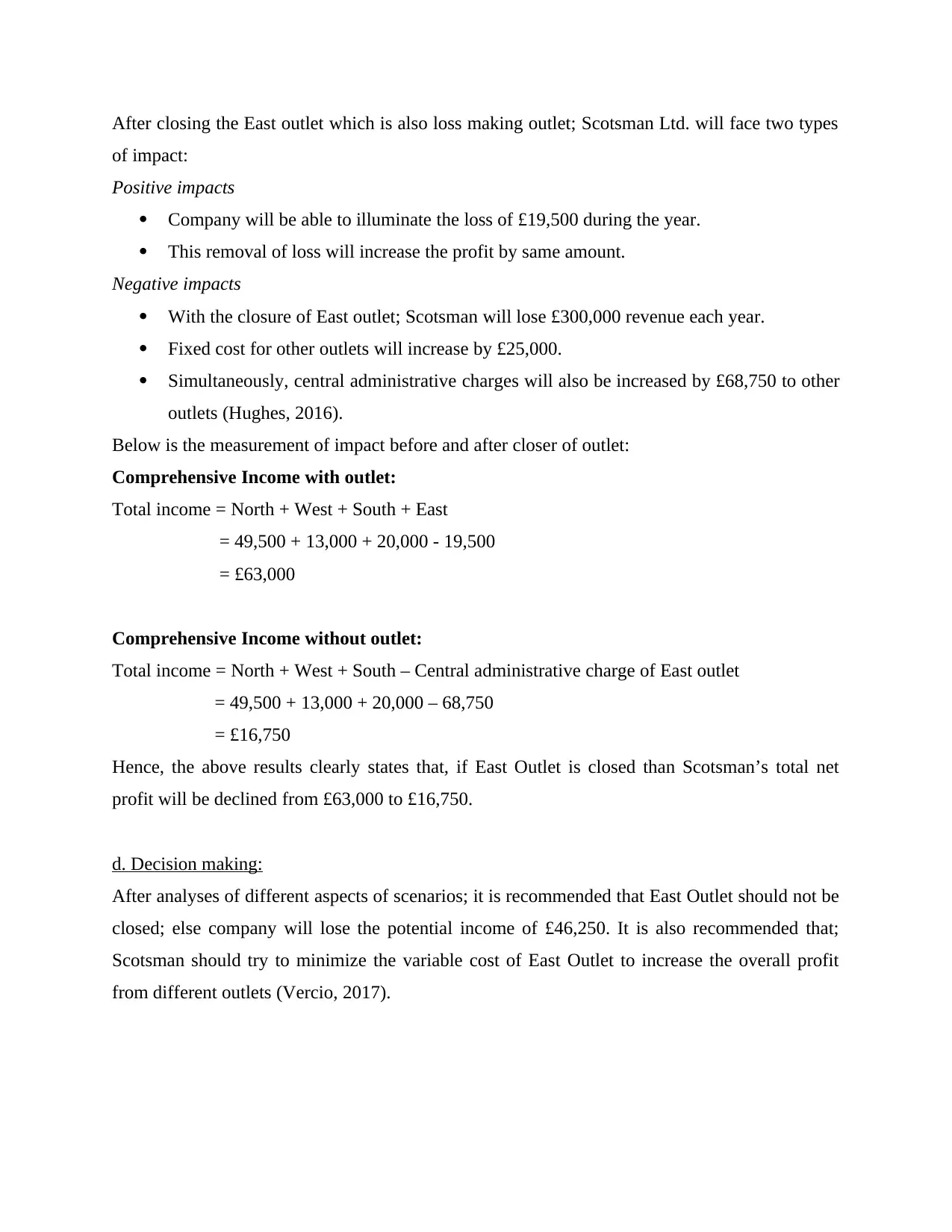
After closing the East outlet which is also loss making outlet; Scotsman Ltd. will face two types
of impact:
Positive impacts
Company will be able to illuminate the loss of £19,500 during the year.
This removal of loss will increase the profit by same amount.
Negative impacts
With the closure of East outlet; Scotsman will lose £300,000 revenue each year.
Fixed cost for other outlets will increase by £25,000.
Simultaneously, central administrative charges will also be increased by £68,750 to other
outlets (Hughes, 2016).
Below is the measurement of impact before and after closer of outlet:
Comprehensive Income with outlet:
Total income = North + West + South + East
= 49,500 + 13,000 + 20,000 - 19,500
= £63,000
Comprehensive Income without outlet:
Total income = North + West + South – Central administrative charge of East outlet
= 49,500 + 13,000 + 20,000 – 68,750
= £16,750
Hence, the above results clearly states that, if East Outlet is closed than Scotsman’s total net
profit will be declined from £63,000 to £16,750.
d. Decision making:
After analyses of different aspects of scenarios; it is recommended that East Outlet should not be
closed; else company will lose the potential income of £46,250. It is also recommended that;
Scotsman should try to minimize the variable cost of East Outlet to increase the overall profit
from different outlets (Vercio, 2017).
of impact:
Positive impacts
Company will be able to illuminate the loss of £19,500 during the year.
This removal of loss will increase the profit by same amount.
Negative impacts
With the closure of East outlet; Scotsman will lose £300,000 revenue each year.
Fixed cost for other outlets will increase by £25,000.
Simultaneously, central administrative charges will also be increased by £68,750 to other
outlets (Hughes, 2016).
Below is the measurement of impact before and after closer of outlet:
Comprehensive Income with outlet:
Total income = North + West + South + East
= 49,500 + 13,000 + 20,000 - 19,500
= £63,000
Comprehensive Income without outlet:
Total income = North + West + South – Central administrative charge of East outlet
= 49,500 + 13,000 + 20,000 – 68,750
= £16,750
Hence, the above results clearly states that, if East Outlet is closed than Scotsman’s total net
profit will be declined from £63,000 to £16,750.
d. Decision making:
After analyses of different aspects of scenarios; it is recommended that East Outlet should not be
closed; else company will lose the potential income of £46,250. It is also recommended that;
Scotsman should try to minimize the variable cost of East Outlet to increase the overall profit
from different outlets (Vercio, 2017).
Paraphrase This Document
Need a fresh take? Get an instant paraphrase of this document with our AI Paraphraser
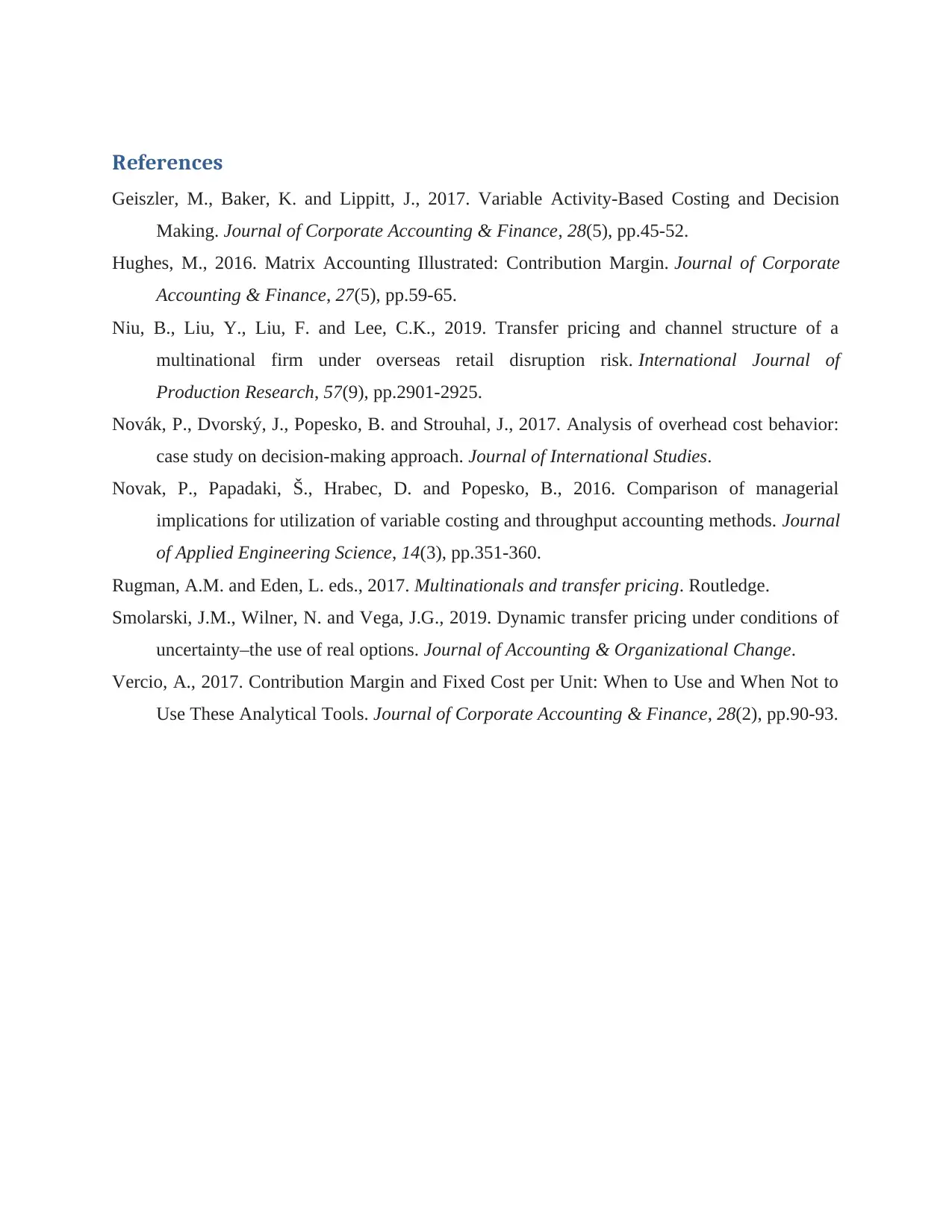
References
Geiszler, M., Baker, K. and Lippitt, J., 2017. Variable Activity‐Based Costing and Decision
Making. Journal of Corporate Accounting & Finance, 28(5), pp.45-52.
Hughes, M., 2016. Matrix Accounting Illustrated: Contribution Margin. Journal of Corporate
Accounting & Finance, 27(5), pp.59-65.
Niu, B., Liu, Y., Liu, F. and Lee, C.K., 2019. Transfer pricing and channel structure of a
multinational firm under overseas retail disruption risk. International Journal of
Production Research, 57(9), pp.2901-2925.
Novák, P., Dvorský, J., Popesko, B. and Strouhal, J., 2017. Analysis of overhead cost behavior:
case study on decision-making approach. Journal of International Studies.
Novak, P., Papadaki, Š., Hrabec, D. and Popesko, B., 2016. Comparison of managerial
implications for utilization of variable costing and throughput accounting methods. Journal
of Applied Engineering Science, 14(3), pp.351-360.
Rugman, A.M. and Eden, L. eds., 2017. Multinationals and transfer pricing. Routledge.
Smolarski, J.M., Wilner, N. and Vega, J.G., 2019. Dynamic transfer pricing under conditions of
uncertainty–the use of real options. Journal of Accounting & Organizational Change.
Vercio, A., 2017. Contribution Margin and Fixed Cost per Unit: When to Use and When Not to
Use These Analytical Tools. Journal of Corporate Accounting & Finance, 28(2), pp.90-93.
Geiszler, M., Baker, K. and Lippitt, J., 2017. Variable Activity‐Based Costing and Decision
Making. Journal of Corporate Accounting & Finance, 28(5), pp.45-52.
Hughes, M., 2016. Matrix Accounting Illustrated: Contribution Margin. Journal of Corporate
Accounting & Finance, 27(5), pp.59-65.
Niu, B., Liu, Y., Liu, F. and Lee, C.K., 2019. Transfer pricing and channel structure of a
multinational firm under overseas retail disruption risk. International Journal of
Production Research, 57(9), pp.2901-2925.
Novák, P., Dvorský, J., Popesko, B. and Strouhal, J., 2017. Analysis of overhead cost behavior:
case study on decision-making approach. Journal of International Studies.
Novak, P., Papadaki, Š., Hrabec, D. and Popesko, B., 2016. Comparison of managerial
implications for utilization of variable costing and throughput accounting methods. Journal
of Applied Engineering Science, 14(3), pp.351-360.
Rugman, A.M. and Eden, L. eds., 2017. Multinationals and transfer pricing. Routledge.
Smolarski, J.M., Wilner, N. and Vega, J.G., 2019. Dynamic transfer pricing under conditions of
uncertainty–the use of real options. Journal of Accounting & Organizational Change.
Vercio, A., 2017. Contribution Margin and Fixed Cost per Unit: When to Use and When Not to
Use These Analytical Tools. Journal of Corporate Accounting & Finance, 28(2), pp.90-93.
1 out of 8
Related Documents
Your All-in-One AI-Powered Toolkit for Academic Success.
+13062052269
info@desklib.com
Available 24*7 on WhatsApp / Email
![[object Object]](/_next/static/media/star-bottom.7253800d.svg)
Unlock your academic potential
Copyright © 2020–2025 A2Z Services. All Rights Reserved. Developed and managed by ZUCOL.





